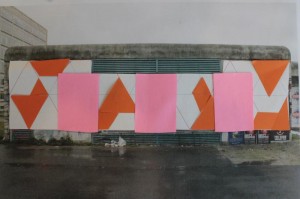After about a hundred ideas (funky, practical, stupid, far-fetched, you name it ! ) that arose out of multiple Skype and online drawing board sessions, we presented some of those ideas consolidated into three concepts. Here’s a brief description of each of them
1. Promo space

The space was proposed to be turned into an event / promotion space / lounge for the students. This could transform the space into an area where the students could relax, socialize as well as reserve it to conduct events. Student projects often need space for conducting user surveys, promotion events etc. They could thus take control of the Gemaal and boost their projects, at the same time providing a lively and comfortable environment in the space around the Gemaal.
2. Street Canvas

The space was proposed to be turned into a public “canvas” that students could paint on, thus inviting the artist in students, providing a visible and not-easily available large canvas with good exposure. This allotment could be done for durations of two weeks each, so as to allow enough number of student artists exposure. This concept also envisioned portraying the receptiveness and openness of the HvA to creativity.
3. Open Air Exhibition

The walls of the Gemaal were proposed to be “themed” as a part of this project, and huge posters to be put up that displayed student projects, announcing , promoting or just describing them. These posers would be made “interactive” by allowing viewers to step on interactive “tiles” that would count the number of people stepping on them. This would not only give feedback about the reception of the project among the audience but also catch attention, involve them and add a “fun” element to it without being too distracting. This project would also easily be able to target both pedestrian as well as vehicular traffic.
It was difficult funnelling, filtering , modifying and fitting multiple ideas into these concepts, but the concepts were well worth it. They were well received, and the assigners, Bureau NieuwBouw were particularly enthusiastic about the Open Air Exhibition concept, and by the suggestion of displaying student work.
In addition, from surveys, interviews and perusing literature, we were able to draw up a list of desirable elements in public space in general and for the HvA in particular, as well as some design guidelines to be followed. These should help us in the phases to follow to make the right decisions.
The approach now is to tailor the Open Air Exhibition concept to take into account requirements of the assigners and various stakeholders, and design the implementation. Lots of work to be done, we better get moving, then !






